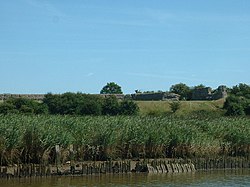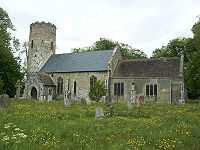Burgh Castle
| Burgh Castle | |
| Suffolk | |
|---|---|
 Burgh Castle fort walls | |
| Location | |
| Grid reference: | TG476049 |
| Location: | 52°35’8"N, 1°39’13"E |
| Data | |
| Population: | 955 |
| Post town: | Great Yarmouth |
| Postcode: | NR31 |
| Local Government | |
| Council: | Great Yarmouth |
Burgh Castle is a village in Suffolk. It is in the northernmost extension of the county, on the east bank of the River Waveney where it opens up into Breydon Water, some four miles west of Great Yarmouth and within the Suffolk Broads.
Roman Fort
- Main article: Burgh Castle Roman Site
Burgh Castle is the site of one of several Roman forts constructed to hold cavalry as a defence against Saxon raids up the rivers of the east and south coasts of southern Britain (the Saxon Shore). Possibly this was Gariannonum, a name that appears in a single source; the identification was once thought secure, but is now thought doubtful by specialists.
The fort is a very large rectangle with three of the tall massively built walls still extant; the fourth fell into what was once an estuary but is now a marsh. Breydon Water is all that is left of the estuary this fort once overlooked. The castle is owned by the Norfolk Archaeological Trust, with the walls in the care of English Heritage. The site is freely open to the public.[1]
Other sites

Since William Camden, Burgh Castle has been suggested as the site of Cnobheresburg, the unknown place (a castrum or fort) in East Anglia, where in about 630 the first Irish monastery in southern Britain was founded by Saint Fursey as part of the Hiberno-Scottish mission described by Bede. Historians find many arguments against this location, but are unable to agree on a better one. The Roman fort at Burgh Castle was excavated by Charles Green during 1958-61. A detailed report by Norfolk Museums Service in 1983 (East Anglian Archaeology 20) shows that there was never any monastic settlement in Burgh Castle itself.
The church of Burgh Castle, St Peter and St Paul is one of 124 existing round-tower churches in Norfolk.
Miscellany
The House of Burke, a family which has spread across the British Isles, prominently in Ireland, takes the original form of the surname, de Burgh, from the area.
Outside links
| ("Wikimedia Commons" has material about Burgh Castle) |
- http://www.norfarchtrust.org.uk/burghcastle/ Historic and visitor information about the Burgh Castle fort.
- Information on Burgh Castle from GENUKI
- History and research on Burgh Castle: English Heritage
- Old England – Burgh Castle
- Roman Map – Burgh Castle
- Church of St Peter and St Paul, Burgh Castle, a round-tower church
- Christian pilgrimage to Burgh Castle
